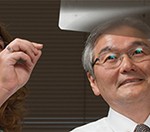He explained that when he first began his current research when still a post-doc at the National Institutes of Health in the 1980s, working under physician-scientists Ethan Shevach and David Cohen, the focus was on studying the role of T cells, not NK cells. It took years of study to understand the role and function of Ly49A and to come to the realization that it had little to do with T cells and more to do with NK cells, says Dr. Yokoyama. Yet he believes unexpected discovery is the beauty of scientific research. “If you always find what you expect you will find there’s no need to do research,” he says.
Dr. Yokoyama says that his supervisors “gave me freedom to study what we wanted. We followed where the science was taking us.”
Along with treating patients, Dr. Yokoyama is a two-time Howard Hughes Medical Institute investigator; professor of medicine, pathology, and immunology; chief of the rheumatology division; and director of the Center for Arthritis and Related Diseases and the Rheumatic Diseases Core Center.
He also directs Washington University School of Medicine’s dual-degree MD-PhD, Medical Scientist Training Program. He holds deep appreciation for the value a good mentor can play in a researcher’s career, a belief acquired from personal experience. His long-term mentor is a high-school biology teacher who encouraged Dr. Yokoyama to pursue his interest in scientific research in high school and has encouraged him throughout his career.
After completing an undergraduate degree in biology at the University of Rochester, Dr. Yokoyama returned to his native Hawaii and obtained a medical degree at the University of Hawaii at Manoa. He completed a residency and a rheumatology fellowship at the University of Iowa Hospitals, in Iowa City, and a research fellowship in immunology at the National Institute of Allergy and Infectious Diseases (NIAID). He joined the Washington University School of Medicine in 1995.
He continues to make new discoveries surrounding NK cell receptors and how the innate immune system controls virus infections at his lab at Washington University.
Using Art to Teach and Inspire

During his more than 20 years of volunteerism for the foundation, Dr. Louie has inspired both physicians and patients by highlighting famous artists, past and present, who had arthritis and related diseases under the foundation’s purview.
He gives patients hope for coping with their disease by illustrating how famous artists managed, artists such as Pierre-Auguste Renoir, Henri de Toulouse-Lautrec, Raoul Dufy, Grandma Moses, and Paul Klee, all of whom had a form of arthritis. Some of the artists were able to manage their disease through the grit of their own determination, the support of family and friends, and by using the best medical advice and therapies available during their lives. Many used their art to express their pain and turmoil, while others preferred to ignore and surpass their pain and deformities through their art.
